Abstract
This article delves into the underexplored intersection of Jewish identities and feminist art. It critically examines artworks by Judit Hersko and Susan Hiller, aligning with evolving identity constructs in contemporary aesthetics. Concepts like “postmemory” link second-generation Jewish artists to past experiences and unveil the erasure of Jewish women’s memory of Jewish genocide. Analyzing Hersko and Hiller’s diverse works, from landscape photography and sculpture to performance art, it underscores their shared pursuit: illuminating lingering “ghosts” of the Holocaust in modern landscapes. Susan Hiller’s The J Street Project represents an ongoing exploration of loss and trauma beyond the Holocaust in Germany, using archives as a dynamic, evolving phenomenon. Judit Hersko’s art calls for bearing witness to a potential climate catastrophe in Antarctica to prompt contemplation of the actions imperative to survival of both humans and non-humans in the future. The article culminates in the exploration of “The Memorial” (2017), an art project by the activist collective Center for Political Beauty that focuses on the resurgence of overt anti-Semitism in Germany. In essence, Hiller and Hersko confront erasures in history and nature, emphasizing justice and repair. Their art, intertwined with a project addressing contemporary anti-Semitism, serves as a testament to the enduring power of feminist art, reflecting, mourning, and transforming a world marked by historical traumas and war.
1. Introduction
In the realm of feminist art, the exploration of Jewish identities has often remained obscured, as was central to my earlier work, Jewish Identities in American Feminist Art: Ghosts of Ethnicity (Bloom 2006). The book delved into the broader cultural and historical context underlying scholarly hesitance to address Jewish identities in the visual arts. Since then, scholars have reprised this issue in new ways, and the discourse has evolved to question fixed and narrow identity constructs and embrace intersectional viewpoints.1
My examination of artworks by Judit Hersko and Susan Hiller aligns with the special issue’s theme, exploring how contemporary aesthetics are shaped by new forms of identity. I aim to highlight the underrepresentation of Jewish feminist art in contemporary discourse, seeking to insert it into the complex dimensions of visual cultural studies and contemporary art history. It aligns with what feminist art historian Amelia Jones argues in her book Self/Image “that the most important legacy of feminism is its politics of positionality”. By this, Jones emphasizes the situatedness of visuality and spectatorship rather than detachment and distance.2
In what follows, I explore how the Holocaust continues to cast a long shadow over the artwork of second-generation Jewish artists’ work, often termed the “second generation” or the “generation after”. Various concepts, such as “absent memory” (Ellen Fine), “received history” (James Young), “haunting legacy” (Gabrielle Schwab), and “postmemory” (Marianne Hirsch), link these artists to past experiences passed down to those who did not directly witness them.3
Marianne Hirsch’s concept of “postmemory”, detailed in her 2012 book The Generation of Postmemory: Writing and Visual Culture After the Holocaust, provides a particularly helpful theoretical framework for analyzing artworks revealing concealed historical knowledge. It emphasizes memory’s emotional and psychological impacts, highlighting shifts in how different generations perceive historical experiences in relation to one another. Hirsch conceptualizes postmemory as a “structure of inter- and transgenerational return of traumatic knowledge and embodied experience”. The concept captures the connections of the “generation after” to the “personal, collective, and cultural trauma of those who came before”. Mediated by imaginative investment and projection, members of this younger generation “remember” the older generation’s experiences, which appear as “memories in their own right”.4 Rooted in postmemory, my feminist approach, as elucidated by Marianne Hirsch, puts emphasis on embodied experience and broadens a historical archive that has previously been neglected by traditional historians and art historians. Such work also contrasts with predominantly male-dominated Holocaust writings and art, emphasizing the importance of addressing the erasure of Jewish women’s memory of Jewish genocide.
In this exploration, I delve into the realms of landscape photography, film, conceptual art, and performance art, focusing on how feminist artists Judit Hersko and Susan Hiller illuminate latent Jewish “ghosts” from the Holocaust in two vastly different contemporary landscapes, Antarctica and Germany.
Hersko’s artwork From the Pages of the Unknown Explorer (2008–2012), addressing the climate crisis, is inflected by the Holocaust as a touchstone, but extends beyond it to include the trauma of witnessing the destruction of non-human life forms in Antarctica. Her work responds to our contemporary climate emergency, a time when our species’ survival hangs in the balance. Her work departs from the distant sublime aesthetics of Romantic art, which is rooted in European Universalism and its pursuit of nature’s conquest. She offers a critical feminist perspective in Antarctica and its landscape tradition to reinterpret the absences in the history of women in Antarctic exploration and science, using fictional approaches that create alternative histories. She rewrites themes of gender, science, exploration, and Jewishness in the time of World War II to rethink our understanding of Antarctica and our interconnected dependence on the non-human world in the context of the present climate crisis. Hersko’s landscapes and oceanscapes include images from her own family album, pre-war photographs of family members who are Holocaust camp survivors, and objects from those who were victims. Drawing inspiration from Walter Benjamin’s allegorical framework from The Arcades Project, her art grapples with the experience of loss and trauma beyond the Holocaust, employing archives, film, sculpture, and photo montage to reimagine history and performance art.
Susan Hiller’s artwork The J Street Project (2002–2005) opens a space for the exploration of affect, embodiment, and intimacy within historical contexts, reworking the rural and urban landscapes of contemporary Germany. Her work stands apart from that of her peers, bringing haunting experiences to the forefront in a context where gender and other identities often fade into historical obscurity. Her J Street Project provides an alternative perspective on the longstanding absence of Jews within the contemporary landscape of Germany. Her work exposes what often remains culturally invisible but is concealed in plain sight. Hiller’s lens captures hundreds of altered street signs throughout Germany that once contained the prefix “Juden” (Jew) until they were changed by the Nazis, then restored during post-war denazification efforts. She wields her camera to stage the repetition of similar images of these street signs that stand in for Germany’s once large Jewish community. Unlike the first generation that testified to their experiences in the hope of providing a therapeutic clarity that would help put the Holocaust “behind them”, Hiller as a member of the next generation looks to ensure that their “postmemory” of events remains an unfinished process, rather than a means toward definitive answers to questions.
Both artists point to erasure within landscapes, requiring viewers to witness without disguising gaps. Their work, labeled as feminist diasporic projects, maps interconnected histories beyond specific events like the Holocaust, creating interconnections and intersections in a global space of remembrance.
Hiller’s The J Street Project was part of a larger effort by Jewish artists to confront their own traumatic history. Such efforts in Germany were often supported and funded by the nation-state that started to reckon with its own dark past starting in the late 1980s. Germany was doing what most nations have not done; to deal publicly with its own historic crimes. In the late 1990s and early 2000s, the country funded multiple large public memorial projects in Berlin and elsewhere, including the Memorial to the Murdered Jews of Europe, the monument to burned books, the installation of thousands of “stumbling stones” built into sidewalks to commemorate individual Jews, Roma, homosexuals, mentally ill people, and other murdered by the Nazis. However, US art historian James Young, who sat on the board for the Memorial to the Murdered Jews of Europe, early on voiced skepticism concerning the success of these projects that turned out to be prescient. For him, “the problem was that in voiding itself of Jews, Germany had forever voided itself of the capacity for a normal, healthy response to Jews and their ideas… It is a terrible, yet unavoidable consequence of the Holocaust itself, this Jewish aphasia, a legacy of mass murder”.5
In recent years, Germany’s memory culture now faces renewed threats from the far right. My argument culminates with an exploration of the art project The Memorial (2017), created by the activist art collective Center for Political Beauty, focusing on the resurgence of overt antisemitism in Germany. As genuine antisemitic sentiments intensify globally, especially after 7 October 2023, the date that marked the beginning of the Israel-Hamas War, the artwork of Hersko, Hiller, and the Center for Political Beauty, deeply embedded in histories scarred by antisemitic violence, assumes renewed significance. I conclude by elaborating on how these ongoing threats emanate not only from Germany’s far right, but also paradoxically from more recent decisions by Germany’s antisemitism bureaucrats to target German and Israeli Jews who are critical of certain Israeli policies. Jewish critics in both countries argue that this points to Germany’s public memory efforts going awry.6
In summary, this article unravels the multifaceted tapestry of Jewish feminist identities, memory, and contemporary art. Through the lens of postmemory, it sheds light on the interconnectedness of historical experiences, advocating for empathy, connectivity, and the reclamation of marginalized narratives. These artists challenge the traditional boundaries of art, history, and memory culture, urging us to engage with the past to construct a more inclusive and enlightened future.
2. The Melancholic Aesthetics of Judit Hersko’s From the Pages of the Unknown Explorer (2008–2012)
Judit Hersko’s journey into Antarctica began in 2008 when she received the National Science Foundation Antarctic Artists and Writers Grant, allowing her six weeks of collaboration with scientists in Antarctica. As an acclaimed installation artist and chair of the Department of Art, Media, and Design at California State University, San Marcos, Hersko’s work bridges the realms of art and science. In 1997, she represented her native Hungary at the Venice Biennale, and her art was featured in the 2007 exhibition “Weather Report: Art and Climate Change”, curated by Lucy Lippard at the Boulder Museum of Contemporary Art.
Judit Hersko’s artwork From the Pages of the Unknown Explorer (2008–2012) constructs an alternative photographic, performative, and cinematic history of exploration and climate science in Antarctica.7 Her aim is to reshape our sensory and perceptual perspectives on the polar regions and evolving conceptions of nature, all within the context of the Anthropocene. In this work, she confronts both the historical fact that women were physically excluded from Antarctica until the 1960s and 1970s and plays with the visual tropes that perpetuated the notion of Antarctica as an all-male domain. Historically, this continent’s human narrative was dominated by heroic polar and oceanic exploration. These narratives, along with Antarctic expedition photography and art spanning the nineteenth to twentieth centuries, have cast Antarctica as a remote wilderness conquered by (Northern European) explorers.
Instead of the traditional view of polar explorers focused on the overwhelming scale of this wilderness and its conquest, Hersko’s work brings the issues associated with it down to a literally graspable and deliberately absurdist small scale as she delves into the intricate and concealed layers of this region’s oceanscape and its fragile relation of interdependent beings. This includes her focus on tiny organisms overlooked during the Heroic Age but now vital to understanding climate change in Antarctica. These planktonic organisms, once abundant, are now threatened by ocean acidification, a less sensational but critical aspect of climate breakdown. Her emphasis on small planktonic organisms challenges conventional essentialist views of women-as-nature, aligning more with contemporary feminist concepts rooted in new materialism and matter. Such small planktonic organisms defy the preference for large mammals, like polar bears, as icons of anthropogenic climate change. Hersko’s fascination with microscopic life forms aligns with contemporary feminist writing on new materialism and matter. Kathryn Yusoff emphasizes that being earthbound is not an inherent naturalized affinity of women with nature, but a position shaped by material and structural relationships.8 Stacy Alaimo in her article “Your Shell on Acid: Material Immersion, Anthropocene Dissolves”, writes on the importance of scale in terms of such relationships, focusing specifically on pteropods: “To ignore the invisible threats of acidity (to these pteropod shells) ….is to imagine that we are less permeable than we are and to take refuge in an epistemological and ontological zone that is somehow outside the time and space of the Anthropocene. This is a call for scale shifting that is intrepidly—even psychedelically—empathetic rather than safely ensconced. It means dwelling in the dissolve…an aesthetic incitement to extend and connect with vulnerable creaturely life and with the inhuman, unfathomable expanses of the seas”.9 For Alaimo, to do this “is a political act and a particular feminist mode of ethical and political engagement”.10
Judit Hersko’s artwork, From the Pages of the Unknown Explorer (2008–2012), takes the form of a performance piece featuring 120 images that blend fiction with history. This work incorporates photographic and cinematic documentation alongside her sculptural objects as in her silicone portrait of Anna Schwartz, which includes the minute pteropods that she studies [Figure 1]. Hersko introduces us to Anna Schwartz, a fictional Jewish female explorer, photographer, and Antarctic biologist from the 1930s. In her narrative, Anna becomes part of Admiral Byrd’s 1939 expedition, disguised as a white man, making her the only woman of that time to work as a biologist and photographer in Antarctica before the 1960s.
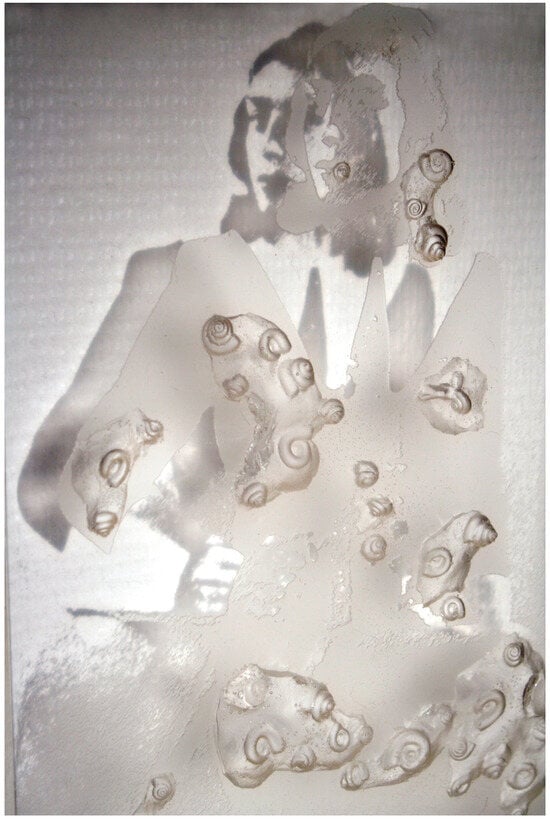
Figure 1.
Judit Hersko, Portrait of Anna Schwartz, 2008. A silicone portrait of the fictional woman Antarctic explorer, Anna Schwartz, that includes a cast sculptural representation of pelagic snails.
The chosen date of 1939 for Schwartz’s trip to Antarctica coincides with Hitler’s invasion of Poland, underscoring the connection to the atrocities in Eastern Europe, where European Jews like Schwartz were sent to concentration camps and made to disappear. This juxtaposition ties Antarctica in the late 1930s to the apocalyptic devastation of the accelerated climate crisis today.11
Hersko draws inspiration from a rich artistic and literary tradition, including Ursula K. Le Guin’s short story “Sur”. This utopian feminist narrative imagines South American women reaching the South Pole in 1909, two years before the official expeditions of Roald Amundsen and Robert Falcon Scott. Hersko’s art is influenced by Le Guin’s female characters, who leave no record of their presence at the South Pole, much like Anna Schwartz’s activities of creating invisible objects in the story. Moreover, like the vanishing ice sculptures in Le Guin’s tale, Hersko’s artwork is ephemeral and only preserved as images and narrative. She emphasizes the fleeting and the minute, and in so doing refuses the physical spectacle afforded by the old flag-planting nationalist heroism and imperial entitlements of explorations to “the ends of the earth”.
To this end, Hersko employs an aesthetic inspired by Victorian women’s surrealist albums avant la lettre, later adopted by avant-garde artists including surrealism as pursued by women artists.12 [Figure 2] This aesthetic style allows her to visually render people in circumstances they would not ordinarily inhabit. The uncanny effect challenges viewers’ perceptions, especially when Anna’s presence is integrated into iconic images from the Heroic Age of exploration. For example, Hersko places Anna in a 1912 photograph of Captain Robert Falcon Scott and his companions at the South Pole, originally captured by Henry Robertson Bowers, an image that famously captures in their posture their exhaustion and sense of defeat, and as such creates an unsettling juxtaposition. [Figure 3].
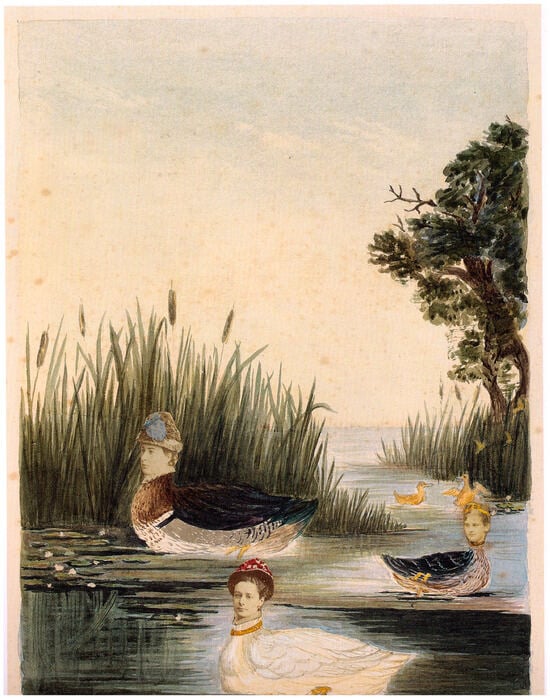
Figure 2.
Kate Edith Gough, untitled collage, late 1870s. Proto-surrealist collage by a Victorian woman who invented a method of photo collage later adopted by avant-garde artists. Source: Gough Album.
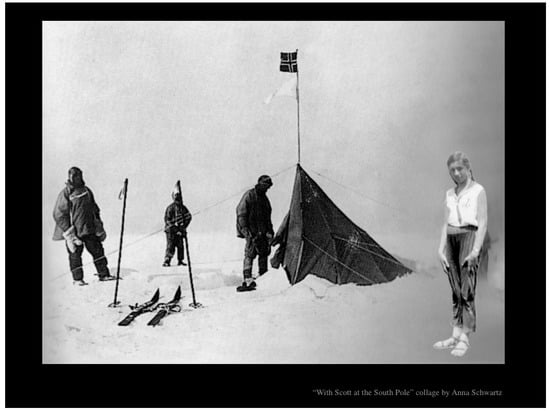
Figure 3.
Judit Hersko, Anna Schwartz: With Scott at the South Pole, 2010. A collage made from Henry Robertson Bowers’s photograph of Captain Scott and his companions beside Amundsen’s tent at the South Pole. Hersko’s fictional explorer, Anna, replaces expedition member Edgar Evans in the foreground. Courtesy of the artist.
Anna’s presence in well-known Antarctic expeditions such as the failed British Scott expedition creates a sense of uncanniness due to being linked not only to the death on the ice of all members of the Scott expedition on their return journey, but also unexpectedly to the murders of Eastern European Jews in the concentration camps, including members of the artist’s own family. She underscores this parallel by including youthful photographs of her own mother, who survived the Holocaust, and her comment that the icy-white objects in her sculptural installations include the candy jar of her mother ‘s own aunt, who, Hersko informs us, died in the Holocaust13 [Figure 4].
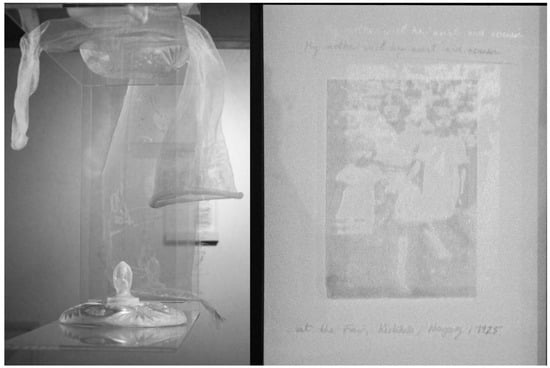
Figure 4.
Judit Hersko, Anna’s Cabinet (details), sculpture, 2011. The featured objects include the candy jar of Anna’s favorite aunt, who died in the Holocaust. Courtesy of the artist.
What makes this compelling and disturbing for viewers in this narrative of loss is how Hersko uses her fictional story about Anna and her daughter’s research on the tiny pteropods, now threatened with extinction, to suggest comparisons between the two genocides. Her art reimagines the articulation of traumatic experience and memory with the sublime awe that Antarctica has inspired since the Heroic Age. However, by switching scale, her images of the pteropods also break with the traditional sublime, emphasizing a different vision of sublimity whose affects were described by Edmund Burke in the 18th century as “the last extreme of littleness is in some measure sublime…” He goes on to write “how we become amazed and confounded at the wonders of minuteness”.14
Through her fascinating representation of the small pteropods, Hersko highlights the snails Clione antarctica (sea angel) and Limacina helicina (sea butterfly), which are often overlooked but crucial to understanding climate breakdown [Figure 5]. These snails were abundant during Anna’s time but are now disappearing in Anna’s daughter’s time. Hersko’s work addresses aspects of global warming that may escape notice because they occur at microscopic levels with gradual transformations. Drawing from Rob Nixon’s concept of “slow violence”, her aesthetic style highlights the long-term cascading challenge of global warming on place and landscape representations (Nixon 2011). Her art reveals what happens in the shadows, underlining the spreading paralysis that people feel as countries worldwide continue to pump out the emissions that cause climate change, and the world remains far off track to avoid catastrophic unraveling.
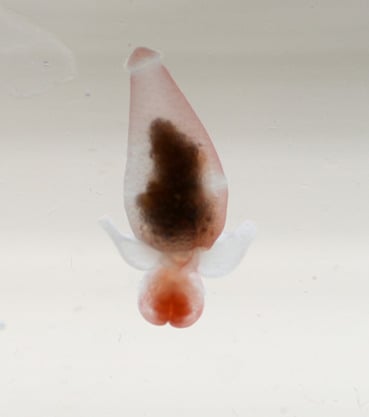
Figure 5.
Judit Hersko, Clione Antarctica—Sea Angel, photograph, 2009. The microscopic gelatinous sea snail in Antarctica is threatened with extinction from climate breakdown. Courtesy of the artist.
Hersko’s art explores representations of these microscopic creatures, creating a melancholic aesthetic that engages with photographic materials from the past but assigns them new value. This melancholia reprises Walter Benjamin’s conception of surrealist allegory in The Arcades Project, where the allegorical figure of the arcade as ruin exemplified the process of integrating the changing meanings of an object as it passes through time and provides a site for melancholic reflection on the transience of human and material existence. Hersko’s work invites us to think of these planktonic snails as having ceased to exist by means of presenting a fictional narrative about their documentation by Anna Schwartz in the 1930s. In the story, Anna Schwartz describes looking at pteropods through a microscope in Herbert Ponting’s darkroom during Robert Byrd’s 1939-1940 expedition. Her archive signifies both moments in time, almost simultaneously. Hersko’s narrative and archive invites us to imagine the lost contributions of women to science, polar exploration, and art history. She offers imaginative histories alongside actual ones, including a dreamlike archive that disorients by shifting the focus of polar exploration, altering our perception of the present, and making connections to other histories as well as current realities, extending to the non-human realm.
3. Jewish Street Signs as “Ghosts” in the Work of Susan Hiller
I now turn to the work by the late Susan Hiller, a US-born British artist who studied and worked as an anthropologist before becoming an artist and settling in London in the early 1970s. Hiller’s multifaceted practice encompassed photography, video, sculpture, painting, artist’s books, and writing. With a career spanning over four decades, she achieved recognition as a central figure in British art, notably marked by a major retrospective at the Tate Modern in 2011. Hiller was celebrated for her groundbreaking large-scale multimedia installations, often exploring aspects of culture that had been overlooked, marginalized, or disregarded.
Born in the United States during WWII, Susan Hiller (1940–2019), belongs to an earlier generation than Hersko (1959–) but grew up further removed from the war. Hiller’s artwork is less autobiographical or familial than Hersko’s but embodies a radical definition of Jewish feminist identity in the shadow of the Holocaust. Hiller responded to this profound historical trauma by challenging traditional categories of landscape and history. Her J Street Project was a critique or reaction against Conceptualism, what she termed “moving sideways from Conceptualism”.15 She states that for her “there was a need to break through the strict patriarchal language of this art movement” and found a way “to do so with humor, irony, horror, personal details, whatever”.16 This is exemplified in The J Street Project, which provides an alternative perspective on the historical absence of Jews in contemporary Germany. At the same time, she is devoted to the seriousness of her conceptual proposition—truth—but brings in moments of irony and grim humor. Through a collection of photographs and film stills, Hiller documented historical voids within narratives, piecing together fragments left in the wake of the Holocaust. She employed a technological-serial approach over a conventional narrative style, which left her room to express the pervasiveness of collective anxieties. Her approach, akin to Hersko’s, carved out space for exploring affect, embodiment, and intimacy as historical concerns in the creation of these new archives, while at the same time shedding light on themes of forgetting, oblivion, erasure, and countering scientific racism, exploitation, and genocide.
Hiller’s involvement in feminist politics dates to the 1960s. Her feminist outlook differed markedly from the visual allure and seduction of pre-World War II social realist art. Instead, she embraced an aesthetics of the unfathomable and the uncanny by deploying the stripped-down aesthetics of 1960s Conceptualism and Minimalism, working against the grain. Her artworks, especially those created from 2002 onwards, align her work with other Jewish feminist artists from Israel and the diaspora who incorporated the memory of the Holocaust into their work. Notable among these women artists are Judy Chicago, Bracha Lichtenberg Ettinger, and Nancy Spero, among others.17
In The J. Street Project, Hiller set herself the monumental task of visiting and documenting all 303 places across contemporary Germany where street names, alleys, and paths contained references to a Jewish absence by bearing the names of their former Jewish residents. Over the course of three years, she meticulously documented every street sign in Germany bearing the prefix “Juden” (Jew) through photography and film. The resulting collection took three distinct forms: a 606-page color photo book filled with sequential photographs, a 67-min slide film, and a monumental installation piece [Figure 6, Figure 7, Figure 8, Figure 9 and Figure 11].18 All three iterations of Hiller’s work constitute an inquiry into the word “Juden” and its absence from street signs during the Nazi period.
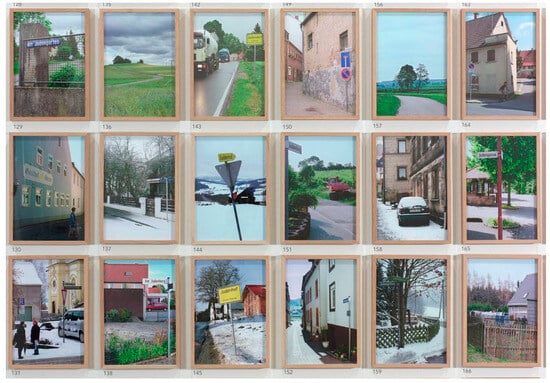
Figure 6.
Susan Hiller, Detail of The J Street Project (Index), 2002–2005. Wall-based installation, 303 archival color inkjet photographs mounted on Kapaline, oak frames. Pigment printed in an almost painterly fashion on watercolor paper and identically sized and framed. Photographs of ordinary German places including inner-city shopping streets, lanes, anonymous suburbs, and secluded country roads all with street signs such as “Judenstrasse” or “Judenwig”. Courtesy of Timothy Tayler Gallery, London.
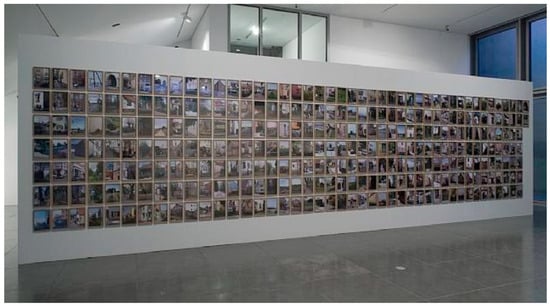
Figure 7.
Susan Hiller, The J Street Project, 2002–2005. A silent procession of thoroughfares that all have the street signs “Judenstrasse” or “Judenwig” that mark them hung in a seven-foot grid. Monumental wall-based installation with 303 archival color inkjet photographs mounted on Kapaline, oak frames. Pigment printed in an almost painterly fashion on watercolor paper and identically sized and framed. Courtesy of Timothy Tayler Gallery, London.
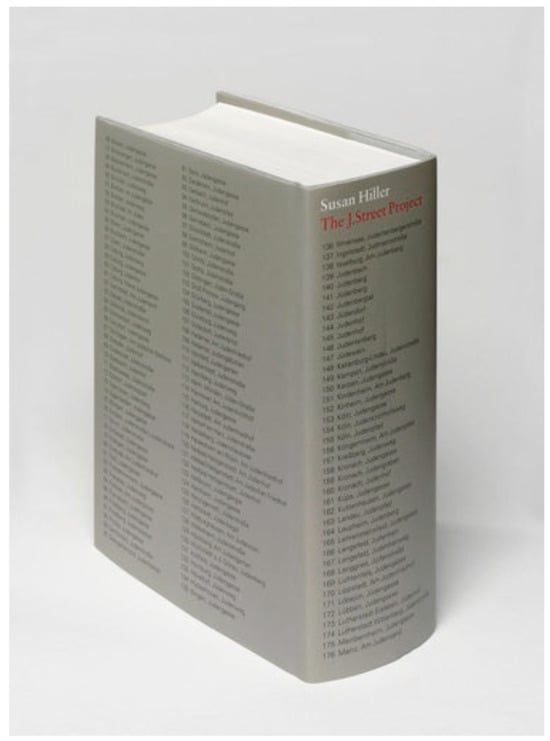
Figure 8.
Susan Hiller, The J Street Project, 2002–2005, a 644-page, cloth-bound book, is part of Hiller’s installation project. Featuring each of the 303 color photographs in the series, captioned, as a map, an introduction by the artist, and an essay by Jorg Heiser; the publication was issued in English and German in a limited-edition of 2000 copies by the Compton Verney House Trust, Warwickshire, England, and the Berlin Artists-In Residence Programme of the German Academic Exchange Service (DAAD), Berlin, in 2005.
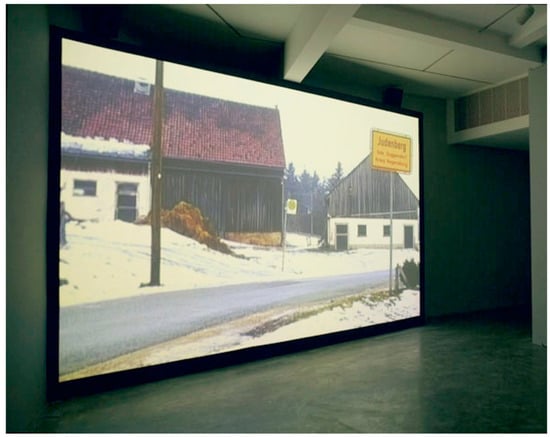
Figure 9.
Susan Hiller, The J Street Project, 2002–2005. Video installation, color, stereo PAL: single channel projection, 67 min, looped. Courtesy of Timothy Tayler Gallery, London.
The film portrays ordinary scenes from the early 2000s that produce a haunting sense of desolation by virtue of the stark facticity of what is in the frame. Hiller incorporates recorded sounds and images into her artwork, exploring the eerie contrast between views of people engaged in daily activities and the ambient sounds of the depicted landscape. [Figure 9] The sounds often include railway crossings and trains, alluding to the deportation of the Jewish population. The film pairs still images with audio featuring innocent sounds like musical box melodies or church bells, reminiscent of childhood experiences. However, these sounds also carry an unsettling, almost perverse undercurrent of impending violence. As viewers watch the film, they are confronted by the sheer number of these signs scattered across various neighborhoods, streets once named after Jews who lived throughout Germany, which later became sites of violence against the Jewish community during World War II, erasing their ancient ethnic identity.
Despite being a straightforward progression of still images, the film offers no commentary or drama. Instead, Hiller employs her camera as a silent witness, commenting on the transformation from presence to absence, and back to a hopefully inadequate presence of the restored signs, compelling viewers to fill in the gaps with their own history and memories. Importantly, Hiller’s artwork refrains from inundating the audience with gruesome reminders of the Nazis and the Holocaust. Instead, the focus remains on seemingly mundane details like houses with lace curtains or a girl riding a bicycle. Paradoxically, it is precisely this portrayal of apparently innocent, not quite kitschy, everyday life that renders the mundane more menacing, heightening the awareness of a history marked by segregation, violence, and loss.
Hiller fittingly refers to these older street signs as “ghosts”, emphasizing that they often go unnoticed. In her words from 2008, “The Jews are gone, but the street names remain as ghosts of the past, haunting the present”.19 Hiller considers them “unconscious memorials” that “nobody intended to leave, but they are there”.20 Her work can evoke strong reactions, as seen during a screening of the “J. Street” film in 2011, when some audience members found it profoundly traumatic. In one instance, Hiller recalls in an interview that “a young German woman verbally confronted her vehemently declaring, ‘I don’t think you should’ve made this work! It has nothing to do with us!’”21 For the viewer there is a split between that which has been actively forgotten or repressed and that which is remembered but often idealized, a process that depending on the situation and the person can evoke self-reflection, or as in the case of the angry viewer, denial, or for others, the work of mourning.
In another later interview at the Contemporary Jewish Museum in San Francisco, Hiller discusses the gap between the public representation of the Holocaust and the personal, everyday experiences of Jews. For her, this gap is evident in contemporary Germany, where Jews remain largely abstract to the general population, despite official awareness of the Holocaust and its public memorials. Ruth Ellen Gruber, in her book Virtually Jewish: Reinventing Jewish Culture in Europe, coined the term “virtually Jewish” to describe the resurgence of interest in Jewish life and culture in Europe at a time when Jews in many countries like Germany are scarce or absent.22 Hiller’s work prompts contemplation of this absence—how it has become more common to encounter street signs referencing Jews than actual Jewish individuals. In many ways, it took a disruptive Jewish feminist perspective to name what often remains culturally invisible yet concealed in plain sight.
4. German Memory Culture and the Center for Political Beauty
Before concluding, I would like to turn to The Memorial, a project undertaken by the Center for Political Beauty in Germany (ZPS) in 2017. This activist art collective specializes in raising public awareness through performances, such as coordinating funerals for migrants who perished on the way to Germany and constructing a replica Holocaust memorial outside the residence of a prominent far-right leader [Figure 10].
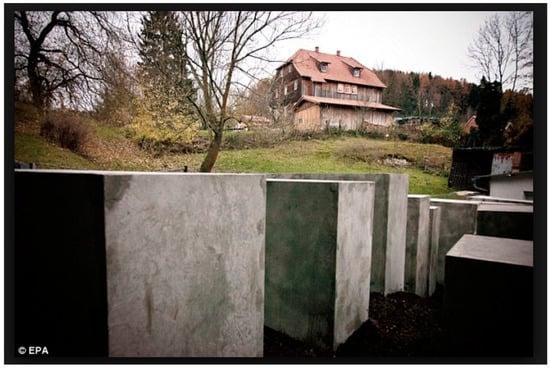
Figure 10.
The Center for Political Beauty in Germany (ZPS), The Memorial, 2017. This is a miniature version of Peter Eisenman’s original Holocaust Memorial to the Murdered Jews in Berlin. The replica was put adjacent to the home of far-right politician Björn Höcke in Bornhagen, Germany, for an activist project by the Center for Political Beauty to serve as a daily reminder to him and his supporters that fostering fascist ideologies anywhere in Germany will provoke unwavering opposition.
Their work sheds light on the recent resurgence of racial hatred and violence associated with far-right wing groups and politicians in Germany. Despite Germany’s earnest efforts to confront its dark history and transition into a liberal democracy, the unexpected rise of far-right movements, as evidenced by the violent events in Chemnitz that emerged during the summer of 2017, underscores the ongoing necessity of safeguarding democratic values.
Amidst the global surge in violent antisemitism, racism, and anti-immigrant sentiments, my interest was piqued by the miniature version of the Peter Eisenman’s original Holocaust Memorial in Bornhagen, a project by the Center for Political Beauty. From February 2017 to 2022, this activist group owned a small property adjacent to the home of far-right politician Björn Höcke in Bornhagen, Germany.23 They orchestrated a remarkable feat, involving a team of one hundred members who, in just five days, erected a replica of the Holocaust memorial to the murdered Jews of Europe in Berlin. This gesture aimed to serve as a poignant reminder to Höcke of the millions of Jews who were systematically murdered.
Höcke, a politician for the far-right Alternative for Germany (AfD) party, had urged citizens to cease atoning for Nazi crimes and had labeled Berlin’s Holocaust memorial as “a monument of shame”. His party opposes Germany’s “memory culture” and calls for an end to national apologies for the country’s dark past.
Placing a miniature version of the Berlin Holocaust memorial near Höcke’s residence serves as a daily reminder to him and his supporters that fostering fascist ideologies anywhere in Germany will provoke unwavering opposition. As stated by The Frankfurter Rundschau, a German daily newspaper based in Frankfurt am Main:
“The Holocaust Memorial is a monument to our shame. We need it so that we don’t forget what we are capable of. Every single one of us needs it. The Center for Political Beauty has erected a private monument in the backyard of one of those people who would like to close their eyes to this reality. He should be grateful”.24
Nevertheless, it is essential to acknowledge that there is a longstanding practice of states and political groups appropriating Holocaust history for their own nationalist agendas. The continued relevance of the Holocaust Memorial in Berlin, originally conceived as a model for countries grappling with the weight of collective memory, has now come into question. This uncertainty paradoxically stems from the establishment of Germany’s commissioner system, which was meant to combat antisemitism but now serves a reactionary agenda. It has come under criticism by German and Israeli Jews for being more focused on alleviating Germans’ feelings of guilt for the Holocaust than on ensuring the safety of Jews.25 Matters took a turn for the worse after October 7, 2023, as Germany and most of its state-funded institutions declared unconditional solidarity with Israel.
Since 2017, Germany has reported a consistent increase in antisemitic incidents, numbering over two thousand in 2019 and exceeding three thousand in 2021. Particularly since the onset of the Israel-Hamas war, within their reporting of antisemitic incidents, German authorities have blurred the lines between violent attacks on Jews on the one hand and what German’s term “Israelbezogener Antisemitismus” or “Israel-related antisemitism” on the other. The latter includes criticisms of Israeli government policies and those who “de-singularize the Holocaust”.26 As Israeli architect and author Ewal Weisman writes: “In Germany, Palestinians are often prohibited by German authorities from demonstrating their grief in vigils for the thousands of Palestinians killed in Gaza. Even calling for a ceasefire may be considered antisemitic in Germany”.27 He goes on to refer to official statistics that show that most antisemitic offenses in the country are in fact committed by white neo-Nazis who enjoy the protection of the police when they continue to march in the streets of Germany. Notably, a growing number of Jewish writers, artists, curators, and scholars who have been critical of Israel after 7 October 2023, have been targeted and shamed under these new laws. Regrettably, the well-intentioned efforts by Germans to earnestly confront their past seem to have veered off course since the 1980s. As Emily Dische-Becker, a left-wing Jewish curator and journalist in Berlin, aptly observed in 2023, “German antisemitism efforts are not driven by a concern for Jews”. She asserted that it ultimately boils down to a very nationalist “German identity politics”.28
5. Conclusions
In conclusion, Susan Hiller’s The J Street Project engages with the Holocaust, yet she does not view her work as confined to the past. Rather, it represents an ongoing exploration of an experience of loss and trauma beyond the Holocaust. She regards the archive she assembled in this project not as a static artifact but as a continually evolving phenomenon of the present. She eloquently states, “The J Street Project has allowed me to reflect not only on one unique, incurable, traumatic absence but also on more recent attempts to destroy minority cultures and erase their presence”.29 Importantly, for Hiller, historical context and trauma are not exclusive to Jews alone. She brings feminist art and concerns for justice and repair to bear on even the most heavily contested conflicts.
Motivated by the devastation and desolation of the Holocaust, Hiller embarked on a mission to document and reconstruct every conceivable facet of the lost Jewish world. Her approach aligns with an aesthetic and ethical practice of postmemory, seeking to reclaim historical specificity and context. In this regard, her archive serves as a means of correction and repair. The ongoing nature of name restoration is exemplified in her original exhibition, which traveled to the Jewish Museums in New York City and San Francisco. The Nazis had renamed Spandau’s Judenstraße to Kinkelstraße, after a 19th-century racial theorist they admired. In 2002, when Hiller initiated her project, the original name was reinstated, but only after a protracted and heated local debate. Hiller’s image poignantly captures both names, with Kinkelstraße crossed out in red and framed by Christmas lights [Figure 11].
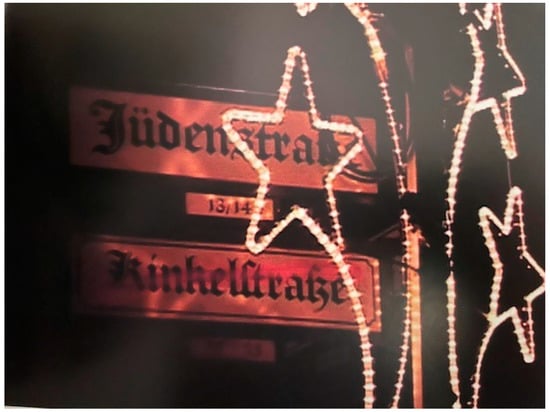
Figure 11.
Susan Hiller, The J Street Project, 2002–2005. Video installation: single channel projection, 67 min, looped. Two signs for the project. This single image is about the ongoing nature of name restoration in Germany as exemplified by this rare example where there are two signs that still exist for the same street, including the original sign--Spandau’s Judenstraße--and the sign bearing the name Kinkelstraße, after a 19th-century racial theorist the Nazis admired.
By contrast, in Judit Hersko’s artwork, the Holocaust connection invites viewers to witness what also must never happen again. We are called upon to bear witness, to a specific future climate catastrophe that has yet to fully unfold. Through her work, Hersko endeavors to prompt contemplation of the actions imperative for the survival of both humans and non-humans in the future. Her art grapples with the challenge of representing phenomena that elude our immediate senses, such as the gradual and imperceptible progression of climate breakdown. Hersko pursues these issues in her earlier installation “Shifting Baselines” (2006) where she confronts ocean acidification directly in “Seven Days of Dissolution” and in a companion piece titled “Winners and Losers” she projects images onto tanks of live jellyfish. She questions the possibility of winners in a cycle of destruction writing: “while jellyfish thrive under current ocean circumstances (they are not affected by acidification) will they survive down the line? And ultimately, even if some non-human life forms may survive environmental destruction, humans will not.”30
Both artists draw attention to an erasure within the landscape that challenges our ability to perceive without a deep sense of displacement and loss. In Hiller’s photographic and cinematic images, she portrays idyllic German village scenes or innocent landscapes that obscure uneasy histories, challenging the viewer to think about the absences. The idea and practice of placing objects like street signs, stories, individuals, and organisms into a relationship of proximity is itself an important component of both these projects and an aspect of the counter-memories that they are attempting to activate. I write about them as feminist diasporic projects because of their focus on mapping connective histories beyond discrete historical events like the Holocaust; histories which extend outside of Israel, Germany, or the US. Their work creates interconnections and intersections in a space of remembrance that transcends the national. Such feminist work can expose both the depth of desolation and an abiding concern for justice and acts of repair. At the same time, it avoids the competition over suffering that comparative approaches can sometimes engender.
In essence, Susan Hiller and Judit Hersko engage with memory and loss through their art, confronting the erasures in history and the disappearances of nature that have profound implications for both individuals and societies. They challenge viewers to acknowledge these absences and witness the unsettling intersections of traumatic history and, in the case of Hersko, to prompt us to not only contemplate but to act. Through Hersko’s distinct yet interconnected practices, she extends an invitation to delve into the complexities of post-Holocaust memory and the urgent need to address the emergency of climate breakdown. Both artists remind us that the work of memory and the pursuit of justice require ongoing dedication, creativity, and a commitment to mending the fabric of our collective past, present, and future.
In a world in which historical traumas persist and ecological challenges are multiplying, the contemporary art of post-Holocaust memory crafted by Hiller and Hersko offers a poignant testament to the enduring power of feminist intersectional art as a vehicle for reflection, mourning, transformation, and action.
Funding
This research received no external funding.
Data Availability Statement
No new data were created or analyzed in this study. Data sharing is not applicable to this article.
Conflicts of Interest
The author declares no conflicts of interest.
Notes
| 1 | Earlier versions of the section on Judit Hersko have been previously published in my 2022 book and other articles, but this version has been significantly revised to be integrated into this article’s very different argument on feminist intersectional art of post-Holocaust memory. The article is an expanded version of a paper that I gave in 2019 for the conference “New Perspectives on Jewish Feminist Art in the United States” at the Yale Institute of Sacred Music, organized by David Sperber. My writing on Judit Hersko first appeared in “Antarctica: Feminist Art Practices and Disappearing Polar Landscapes”, in Bloom (2017); as Bloom (2020), and in my 2022 book: (Bloom 2022). |
| 2 | Amelia Jones (2006), Self/Image. |
| 3 | See Ellen Fine (1988), “The Absent Memory”; James Young (1997), “Toward a Received History of the Holocaust”; Gabrielle Schwab (1989), Haunting Legacies; and Marianne Hirsch (2012), The Generation of Postmemory: Writing and Visual Culture After the Holocaust. The evolving field of Jewish feminist art has been taken up by a wide range of international scholars and includes the following: Matthew Baigell, Samantha Baskind, Paula Birnbaum, Ala Efimova, Tamar Garb, Rachel Garfield, Marianne Hirsch, Norman Kleeblatt, Laura Kruger, Cassandra Langer, Gail Levin, Laura Levitt, Eunice Lipton, Richard Meyer, Margaret Olin, Mor Presiado, Griselda Pollock, Lisa Salzman, Efraim Sicher, Catherine Soussloff, David Sperber, Roni Tzoreff, Edward Von Woolen, Diane Wolfthal, and Tanya Zion- Waldoks, among others. |
| 4 | Marianne Hirsch (2012), pp. 5–6. |
| 5 | Janes E. Young (2000), p. 196. |
| 6 | Susan Neiman (2023), p. 59. |
| 7 | See Hersko’s website, http://www.judithersko.com/, for images and a full description of her Antarctic art project From the Pages of the Unknown Explorer. Hersko’s artwork on climate change and planktonic snails is an outgrowth of her collaboration with the biological oceanographer Victoria Fabry. See also Hersko’s articles “‘Translating’ and ‘Retranslating’ Data”, “Pages from the Book”, and “Objects” (Hersko 2009). For more on the performance of From the Pages of the Unknown Woman (2008–2012) see Hersko (2012, 2018). |
| 8 | Kathryn Yusoff (2022), p. 27. |
| 9 | Stacy Alaimo (2017), p. 114. |
| 10 | See note 9 above. |
| 11 | Lüdecke and Summerhayes (2012), Third Reich in Antarctica. |
| 12 | See Whitney Chadwick (1991), Women Artists and the Surrealist Movement. |
| 13 | Hersko’s work also pays homage to her mother, Anna Hersko, one of the first women filmmakers in Hungary, who passed away as Hersko was beginning this work. |
| 14 | Edmund Burke (2015), p. 55. |
| 15 | Alexandra M. Kokoli (2011), “Moving Sideways and Other ‘Sleeping Metaphors’: Susan Hiller’s Paraconceptualism”. pp. 143–154. |
| 16 | (Gallagher 2011), Susan Hiller (2011), Yve-Alain Bois and Guy Brett in conversation”, p. 26. |
| 17 | See Marianne Hirsch (2012), pp. 133–52, 216–24. |
| 18 | Susan Hiller (2005), The J. Street Project, essay by Jorg Heiser, Berlin: German Academic Exchange service (DAAD), 2005. |
| 19 | Susan Hiller’s quotes appeared in a short article on the Contemporary Jewish Museum in San Francisco’s website at the time of her exhibit there in the summer of 2009: https://www.thecjm.org/exhibitions/58, (accessed on 2 June 2023). |
| 20 | See discussion on Youtube with Susan Hiller and Dan Shiffrin at the Contemporary Jewish Museum in San Francico, June 18, 2009: https://www.youtube.com/watch?v=594aCcLjHgs, (accessed on 2 June 2023). |
| 21 | (Gallagher 2011). See note 16 above. |
| 22 | Ruth Ellen Gruber (2002), Virtually Jewish: Reinventing Jewish Culture in Europe, p. 7. |
| 23 | For more on how the Holocaust replica shed light on the connections between far-right politicians in Germany and public servants in formerly Communist East German states, see Philip Oltermann, “Holocaust Memorial replica stunt to the murdered Jews of Europe in Berlin shines light on rightwing radicalism in Germany”. The Guardian, April 7 2019: https://www.theguardian.com/world/2019/apr/07/holocaust-memorial-replica-stunt-shines-light-on-rightwing-radicalism-in-germany, (accessed on 2 June 2023). |
| 24 | For the full quote see the website for the Center for Political Beauty: https://politicalbeauty.com/memorial.html, (accessed on 2 June 2023). |
| 25 | George Prochnik, Eyal Weisman and Emily Dische-Becker, “Once Again, Germany Defines Who is a Jew”. (Part One and Two) 2023, Granta. https://granta.com/once-again-germany-defines-who-is-a-jew-part-i/; https://granta.com/once-again-germany-defines-who-is-a-jew-part-ii/, (accessed on 2 June 2023). |
| 26 | Masha Gessen, “In the Shadow over the Holocaust”. New Yorker: https://www.newyorker.com/news/the-weekend-essay/in-the-shadow-of-the-holocaust (accessed on 9 December 2023). |
| 27 | George Prochnik, Eyal Weisman and Emily Dische-Becker, “Once Again, Germany Defines Who is a Jew”. Part II. |
| 28 | Ibid. |
| 29 | Susan Hiller’s quotes appeared at the end of a section titled “About the Exhibit” on the Contemporary Jewish Museum in San Francisco’s website from her 2009 exhibit The J Street Project J: https://www.thecjm.org/exhibitions/58, (accessed on 2 June 2023). |
| 30 | The quote commenting on her 2006 installation titled “Shifting Baselines” is from a private correspondence dated January 29, 2024. In “Winners and Losers” mentioned in that quote, Hersko projects a clip from Nicolas Rogue’s famous 1985 British film drama Insignificance onto two tanks of live jellyfish. For more information about this work visit: https://www.judithersko.com/shiftingbaselines-831071.html. (accessed on 2 June 2023). |
References
- Alaimo, Stacy. 2017. Your Shell on Acid: Material Immersion, Anthropocene Dissolves. In Anthropocene Feminism. Edited by Richard Grusin. Minnesota: University of Minnesota Press, pp. 89–120. [Google Scholar]
- Bloom, Lisa E. 2006. Jewish Identities in American Feminist Art: Ghosts of Ethnicity. London: Routledge. [Google Scholar]
- Bloom, Lisa E. 2017. Antarctica: Feminist Art Practices and Disappearing Polar Landscapes. In The Handbook on the Politics of Antarctica. Edited by Klaus Dodds, Alan J. Hemmings and Peder Roberts. London: Edward Elgar, pp. 84–102. [Google Scholar]
- Bloom, Lisa E. 2020. Planetary Precarity and Feminist Environmental Art Practices in Antarctica. Journal of Postcolonial Writing 56: 547–67. [Google Scholar] [CrossRef]
- Bloom, Lisa E. 2022. Climate Change and the New Polar Aesthetics: Artists Reimagine the Arctic and Antarctic. Durham: Duke University Press. [Google Scholar]
- Burke, Edmund. 2015. A Philosophical Enquiry into the Origin of Our Ideas of the Sublime and Beautiful. Oxford: Oxford University Press. [Google Scholar]
- Chadwick, Whitney. 1991. Women Artists and the Surrealist Movement. London: Thames and Hudson, Originally published in 1985. [Google Scholar]
- Fine, Ellen. 1988. The Absent Memory: The Act of Writing in Post-Holocaust French Literature. In Writing and the Holocaust. Edited by Berel Lang. New York: Holmes and Meier, pp. 41–57. [Google Scholar]
- Gallagher, Ann, ed. 2011. Susan Hiller Catalogue. London: Tate Publishing. [Google Scholar]
- Gruber, Ruth Ellen. 2002. Virtually Jewish: Reinventing Jewish Culture in Europe. Berkeley: University of California Press. [Google Scholar]
- Hersko, Judit. 2009. ‘Translating’ and ‘Retranslating’ Data: Tracing the Steps in Projects That Address Climate Change and Antarctic Science. Paper presented at Digital Arts and Culture Conference, University of California, Irvine, CA, USA, December 12–15; Available online: http://escholarship.org/uc/item/40z2b75n (accessed on 2 June 2023).
- Hersko, Judit. 2012. Pages from the Book of the Unknown Explorer. In Far Field: Digital Culture, Climate Change, and the Poles. Edited by Jane D. Marsching and Andrea Polli. Bristol: Intellect, pp. 61–75. [Google Scholar]
- Hersko, Judit. 2018. Objects from Anna Schwartz’s Cabinet of Curiosities. In Future Remains: A Cabinet of Curiosities for the Anthropocene. Edited by Gregg Mitman, Marco Armiero and Robert S. Emmett. Chicago: University of Chicago Press, pp. 182–90. [Google Scholar]
- Hiller, Susan. 2005. The J. Street Project. Edited by Jorg Heiser. Berlin: German Academic Exchange Service (DAAD). [Google Scholar]
- Hiller, Susan. 2011. Yve-Alain Bois and Guy Brett in Conversation. Edited by Ann Gallagher and Susan Hiller. London: Tate Publishing. [Google Scholar]
- Hirsch, Marianne. 2012. The Generation of Postmemory: Writing and Visual Culture After the Holocaust. New York: Columbia University Press. [Google Scholar]
- Jones, Amelia. 2006. Self/Image: Technology, Representation and the Contemporary Subject. London: Routledge. [Google Scholar]
- Kokoli, Alexandra. 2011. Moving Sideways and Other ‘Sleeping Metaphors’: Susan Hiller’s Paraconceptualism. In Susan Hiller. London: Tate Publishing. [Google Scholar]
- Lüdecke, Cornelia, and Colin P. Summerhayes. 2012. The Third Reich in Antarctica: The German Antarctic Expedition, 1938–39. Norwich: Erskine. [Google Scholar]
- Neiman, Susan. 2023. Historical Reckoning Gone Haywire. In The New York Review of Books. October 19, pp. 58–60. Available online: https://www.nybooks.com/articles/2023/10/19/historical-reckoning-gone-haywire-germany-susan-neiman/ (accessed on 2 June 2023).
- Nixon, Rob. 2011. Slow Violence and the Environmentalism of the Poor. Cambridge: Harvard University Press. [Google Scholar]
- Schwab, Gabrielle. 1989. Haunting Legacies: Violent Histories and Transgenerational Trauma. New York: Bewrg Publishers. [Google Scholar]
- Young, James. 1997. Toward a Received History of the Holocaust. History and Theory 36: 21–43. [Google Scholar] [CrossRef]
- Young, James. 2000. At Memory’s Edge: After-images of the Holocaust in Contemporary Art. New Haven: Yale University Press. [Google Scholar]
- Yusoff, Kathryn. 2022. Earth as a Medium of Struggle. In Re/Sisters: A Lens on Gender and Ecology. Edited by Alona Parado. London: Barbican Prestel, pp. 27–36. [Google Scholar]
Disclaimer/Publisher’s Note: The statements, opinions and data contained in all publications are solely those of the individual author(s) and contributor(s) and not of MDPI and/or the editor(s). MDPI and/or the editor(s) disclaim responsibility for any injury to people or property resulting from any ideas, methods, instructions or products referred to in the content. |
© 2024 by the author. Licensee MDPI, Basel, Switzerland. This article is an open access article distributed under the terms and conditions of the Creative Commons Attribution (CC BY) license (https://creativecommons.org/licenses/by/4.0/).